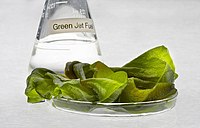
Photo from wikipedia
Enormous marine biodiversity offers an endless reservoir of chemicals for many applications. In this scenario, the extraction of seaweeds represents an interesting source of compounds displaying antimicrobial activity. In particular,… Click to show full abstract
Enormous marine biodiversity offers an endless reservoir of chemicals for many applications. In this scenario, the extraction of seaweeds represents an interesting source of compounds displaying antimicrobial activity. In particular, among the different red algae, Gracilaria gracilis plays an important role due to the presence of important bioactives in its composition. In spite of these features, an efficient culture system is still absent. In the present study, a novel algal culture method was developed and compared to another more common cultural practice, widely reported in literature. A higher efficiency of the new method, both for daily growth rate and biomass, was assessed. Furthermore, the growth inhibitory activity of five extracts, obtained using ethanol, methanol, acetone, chloroform or diethyl ether as a solvent, from the cultured G. gracilis was tested against Gram-positive and Gram-negative pathogens. Algal extracts exhibited a considerable inhibitory activity against B. subtilis strains, while a slight inhibition was observed against V. fischeri. The different extracts showed significant differences in bacterial growth inhibition, with the highest activity that was recorded for the ethanol extract, followed by that of methanol. Based on the chemical characterization, these findings could be related to the antimicrobial activity played by the combination of total carbohydrates and polyphenols, which were determined at high levels in ethanol and methanol extracts, as well as by the highest number and levels of single polyphenols. Conversely, the lower growth inhibitory activities found in chloroform and diethyl ether extracts could be related to the isolation of minor lipid classes (e.g., neutral and medium polar lipids) composed by fatty acids, such as stearic, oleic and arachidonic acids, typically characterized by antimicrobial activity. In consideration of the results obtained, the present study has a double implication, involving both the field of cultural practices and the exploitation of natural sources for the isolation of antimicrobial agents useful both in pharmaceutical and food applications.
Journal Title: Marine Drugs
Year Published: 2018
Link to full text (if available)
Share on Social Media: Sign Up to like & get
recommendations!